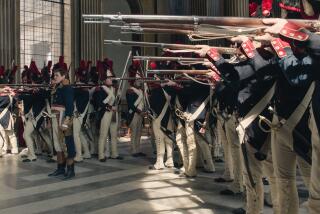Scientists Expose Secrets of the First Photograph
- Share via
In 1827, Frenchman Joseph Nicephore Niepce placed a metal plate coated in a strange chemical in the window of his country home. The concoction baked in the sun for eight hours, creating a hazy image in silver and black--the first known photograph.
The mystery of Niepce’s image has perplexed scientists for years, in part because it is now too fragile to directly examine.
For the record:
12:00 a.m. June 28, 2002 For The Record
Los Angeles Times Friday June 28, 2002 Home Edition Main News Part A Page 2 National Desk 5 inches; 205 words Type of Material: Correction
Photo historian--An article in Thursday’s Section A about the world’s oldest photograph misspelled the name of photographer and photo historian Helmut Gernsheim.
Scientists at the Getty Conservation Institute announced Wednesday that they have finally solved its chemical secrets. Through the use of nondestructive techniques in which different wavelengths of light were shined on the photograph to determine its chemical makeup, the scientists confirmed that the plate is made of pewter, and its chemical coating consists of an asphalt-like substance called bitumen. They found that Niepce washed the plate using oil of lavender to expose the finished image.
“Everything in imaging goes to this one moment in history,” said Dusan Stulik, senior scientist at the Getty Conservation Institute.
The analysis was the first scientific examination of the photo. Understanding the exact chemical composition of the photograph and the process by which it was made is important to determining how to preserve the work.
Scientists spent the last two weeks trying to unlock the secrets of the photo, which has been sealed in box of inert argon gas to protect against decay. Researchers never touched the plate.
From the new findings, along with historical accounts of the work, scientists were able to detail how Niepce (pronounced Nee-ps) created “View from the Window at Le Gras.” The bitumen-coated plate was placed in a simple camera. Portions of the bitumen coating were hardened by the sun. Less-exposed sections were removed using the oil of lavender, a common solvent of the time, revealing the image of farm buildings and a pear tree.
Looking closely at the photograph, which Niepce termed a heliograph, one can see that the buildings on both sides of the scene are illuminated, reflecting the changing position of the sun as it moved across the sky during the eight-hour exposure.
The image is still difficult to see and can only be viewed from an oblique angle. The shiny plate has been notoriously difficult to capture with current photographic techniques.
Nonetheless, viewing the plate is “magical,” said Ray Flukinger, senior curator of photography and cinema at the University of Texas Harry Ransom Center, which owns the photograph.
Niepce, an inventor who also worked on a type of jet engine, began experimenting with the concept of photography in 1798 as a way to reproduce engravings. He tested several chemicals, searching for a light-sensitive compound that could also be “fixed” to the plate to create a permanent image.
He experimented with silver halides, the photosensitive chemical used in today’s photography, but couldn’t find a way to make the image permanent. The solution was discovered in 1839 by Louis Daguerre, who is often called the father of photography.
The two men collaborated for several years, but Niepce died in 1833 before their work could be finished. Daguerre continued to build on principles developed by Niepce to produce the daguerreotype, which became popular in the mid-1800s.
Niepce’s first photograph was lost for almost half a century. It was rediscovered in 1952 by art collector Helmut Gernshiem in the attic of a London home, and brought to the U.S. in 1963 when it was bought by the Harry Ransom Center.
Scientists at Getty Conservation Institute will restore the original frame of the photo and develop a special oxygen-free box so the work can be displayed.





